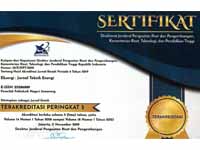KECEPATAN ALIRAN MASUK TERHADAP NILAI TOTAL SUSPENDED SOLID (TSS) PADA OVERFLOW HYDROCYCLONE MENGGUNAKAN METODE COMPUTATIONAL FLUID DYNAMIC (CFD) PADA PT.PLN (PERSERO) PEMBANGKITAN TANJUNG JATI B UNIT 3 DAN 4
DOI:
https://doi.org/10.32497/eksergi.v11i2.261Abstract
Limbah cair coal yard merupakan kontributor besar kandunganTSS utama pada Waste Water Treatment Plant (WWP).Limbah cair tersebut tidak dapat langsung dibuang ke laut, karena nilaiTSS pada limbah masih tinggi.Untuk mengurangi beban kerja di WWTP akibat TSS tersebut, kemudian muncul gagasan pemasangan hydrocyclone untuk menggantikan peran WWTP. Untuk merealisasikan pemasangan hydrocyclone dan menghemat biaya pemasangan dapat dilakukan terlebih dahulu dengan pendekatan permodelan menggunakan metode Computational Fluid Dynamic (CFD).Pada tulisan ini akan dibahas pengaruh kecepatan terhadap persentase pemisahan partikel untuk mengurangi nilai TSS overflow pada hydrocyclone menggunakan Aplikasi Computational Fluid Dynamic (CFD). Variasi kecepatan dilakukan untuk mengetahui pengaruhnya terhadap persentase pemisahan partikel. Variasi kecepatan yang digunakan yaitu 4,066 m/s, 4,513 m/s, 4,841 m/s, 5,083 m/s, 6,861 m/s dan 10,674 m/s. Dari hasil simulasi didapatkan bahwa variasikecepatan cukup berpengaruh terhadap persentase pemisahan partikel, dimana semakin tinggi kecepatan inletmaka persentase pemisahan partikel semakin besar. Pada Tugas Akhir ini nilai effisiensi terbaik dari hasil simulasi hydrocyclone terjadi pada kecepatan 6,861 m/s dengan nilai effisiensi 77,02 %, sehingga untuk memperoleh nilai TSS yang dihasilkan 100 mg/L maka nilai TSS yang harus dimasukkan sebesar 435,161 mg/l, agar tidak mencemari lingkungan.Kata kunci : Kecepatan, Hydrocyclone, CFD, TSS
Downloads
Published
Issue
Section
License
Authors who publish with this journal agree to the following terms:Authors retain copyright and grant the journal right of first publication with the work simultaneously licensed under a Creative Commons Attribution License that allows others to share the work with an acknowledgement of the work's authorship and initial publication in this journal.
Authors are able to enter into separate, additional contractual arrangements for the non-exclusive distribution of the journal's published version of the work (e.g., post it to an institutional repository or publish it in a book), with an acknowledgement of its initial publication in this journal.
Authors are permitted and encouraged to post their work online (e.g., in institutional repositories or on their website) prior to and during the submission process, as it can lead to productive exchanges, as well as earlier and greater citation of published work (See The Effect of Open Access).






